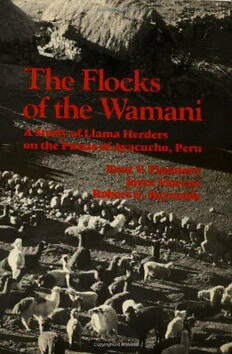
The Flocks of the Wamani: A Study of Llama Herders on the Punas of Ayacucho, Peru PDF
Preview The Flocks of the Wamani: A Study of Llama Herders on the Punas of Ayacucho, Peru
The Flocks of the Wamani Llamas at dawn in their corral, Pallqa, Ayacucho. The Flocks of the Wamani A Study of Llama Herders on the Punas of Ayacucho, Peru Kent V. Flannery Joyce Marcus Robert G. Reynolds Left ~ Coast Press Inc. Walnut Creek, California fi Coast Left press Inc. LEFT COAST PRESS, INC. 1630 North Main Street, #400 Walnut Creek, CA 94596 http://www.LCoastPress.com Copyright © 2009 by Left Coast Press, Inc. Replaces edition of this book produced by Emerald Group Publishing under ISBN 978-0-12-259836-4 in 2007. Originally published by Academic Press in 1989. All rights reserved. No part of this publication may be reproduced, stored in a retrieval system, or transmitted in any form or by any means, electronic, mechanical, photocopying, recording, or otherwise, without the prior permission of the publisher. Library of Congress Cataloguing-in-Publication Data available from the publisher. ISBN: 1-59874-460-7 978-1-59874-460-6 Printed in the United States of America @>TMThe paper used in this publication meets the minimum requirements of American National Standard for Information Sciences-Permanence of Paper for Printed Library Materials, ANSI/NISO Z39.48-1992. 09 10 11 12 13 5 4 3 2 1 for our llamkaccmasi RAMIRO MATOS whose love of the puna, and all things Quechua, been an inspiration Contents Preface ix Acknowledgments xi 1. Introduction 1 2. Andean Nature 11 3. Andean Culture 25 4. The People of the Puna 39 5. The Guanaco and the Llama 89 6. Herd Dynamics I: The "Oliver Twist" Model 119 7. Herd Dynamics II: The "Santa Claus" Model 13 7 8. Chupa and Waytakuy 143 9. Herd Dynamics III: The "Surf City" Model 183 10. Herd Dynamics IV: Sufiay and Adaptation 193 11. Sufiay and Dual Inheritance Theory 205 12. Nature, Culture, and Practical Reason 211 References 219 Index 233 vii Preface One the most hotly debated subjects of the last two decades is the underlying cause of human behavior. Sociobiologists have insisted that its roots are to be found in evolutionary biology, arguing that much of human behavior stems from the pursuit of fitness in the reproductive sense. Many anthropologists have refused to assign so large a role to the 2elletlc component, but they do see the causes of social behavior as func, For some, human behavior represents a kind of ecological adapta tion to the environment, while for others it the application of practical reason to economic or sociopolitical problems. A large number of symbolic anthropologists reject both biology and practical reason, citing the arbitrary nature of many cultural institutions and the apparent failure of functional, ecological, and biological frameworks to explain them. If ever there was a human group well suited to the testing all these competing frameworks, it is the llama herders of Peru's Ayacucho high lands. These Quechua-speaking Indians occupy a bleak tundra environ, ment above 4000 meters, noted for its stressful high altitude and relentless cold. Archaeological and ethnohistorical data indicate that herders have occupied the zone for thousands of years, long enough to have undergone both physical and cultural adaptation. With both their fertility and that of their llamas depressed by the extreme environment, they should provide raw material for anyone concerned with maximizing fitness. Yet the herd ers of Ayacucho also live in a world rich in arbitrary symbolism and filled with powerful supernaturals on whose whim the success of their herding depends. The possibilities for biological adaptation, practical reason, and arbitrary symbolic behavior are so great that rigorous testing and historical reconstruction are needed to evaluate their respective roles. ix
